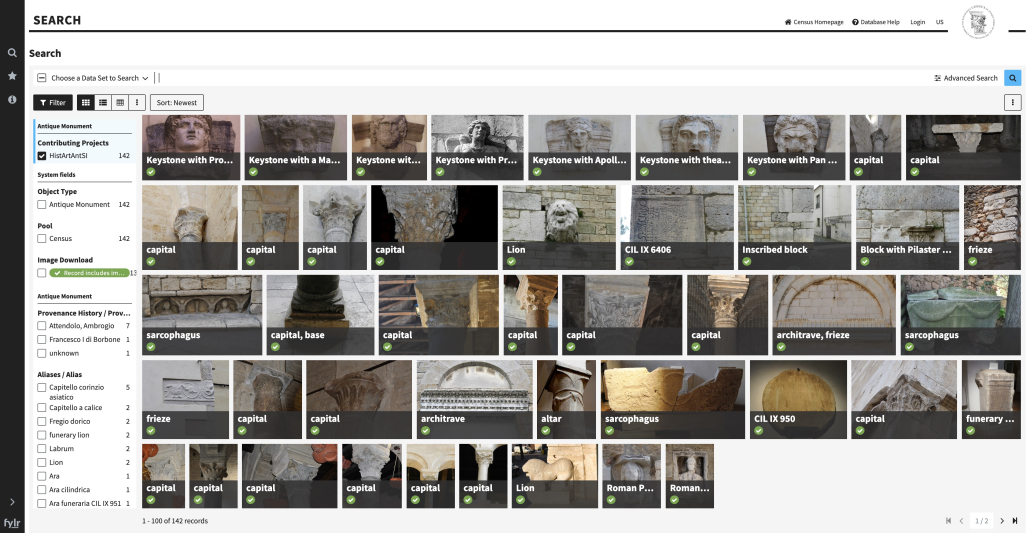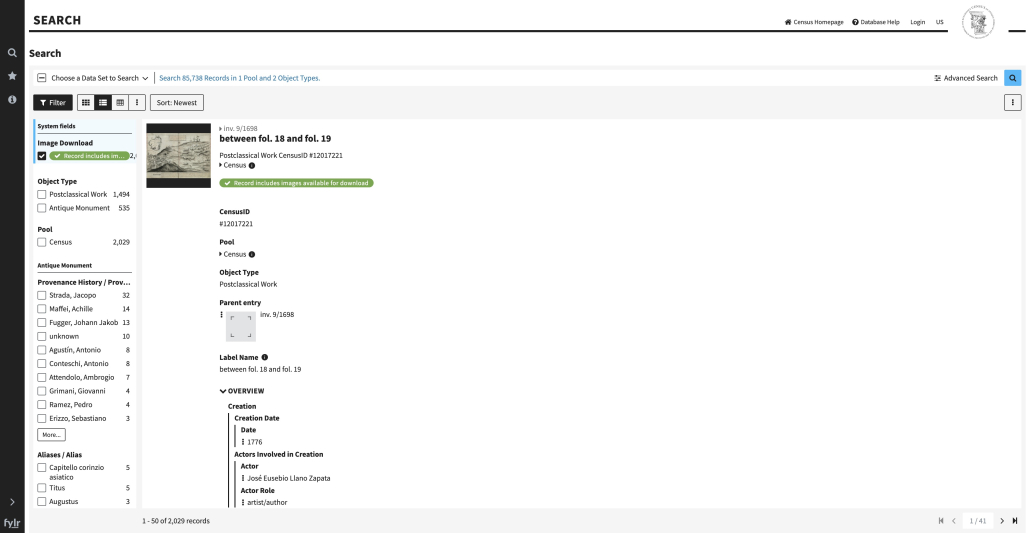The Census Project: Reconstructing the Renaissance using fylr
The origins and goals of the census project
Introduction
“Census of Ancient Works of Art and Architecture Known in the Renaissance” is a project with a 75-year history. Over the decades, it has experienced impressive development through international efforts. The project was initiated in 1946 by German art historians in exile in London and New York. Since the 1990s it has been anchored at the Institute for Art and Visual History at the Humboldt University in Berlin.
The aim of the census project is to reconstruct Renaissance knowledge about antiquity (1400-1600). For this purpose, ancient monuments such as statues and buildings are linked with Renaissance texts (travel guides, descriptions) and images (prints, drawings, medals).
The Census project was a pioneer of digitalization in the humanities. The creation of the first database in the 1980s was funded by the Los Angeles-based J. Paul Getty Trust. The J. Paul Getty Trust is intensively dedicated to art history, archeology and dam research areas.
Several factors make managing the Census database challenging:
- The complexity and size of their inventory.
- The representation of diverse relationships between works of art and texts.
- The management of image material , influenced by different copyright agreements.
- The need to serve search queries
Reasons for choosing easydb compared to other solutions
In 2007, the census database was integrated into easydb , replacing the previous database platform with a web-based solution without access restrictions. In 2021-2022, major software updates took place and a new user interface for the Census project was developed. At the same time, the database was prepared for transformation into the Linked Open Data format. The photographic inventory was also updated, making the latest images of ancient monuments and drawings available.
A decisive factor for the renewed choice of easydb , especially in its successor version “ fylr ”, was the already existing long-term cooperation. In addition, the software was adaptable to the specific requirements of the census project.
Implementation of the fylr version in the Census project
could switch to the new version of easydb , the fylr This in itself was already a challenge. In addition, a version jump was made from easydb version directly to fylr ; easydb easydb was skipped. This meant that intensive and ongoing coordination between the Census project team and the Programmfabrik necessary over the course of the project in order to successfully complete the migration.
Influence of easydb and fylr on the Census project
Integrating fylr into the Census project has significantly improved the team's workflow. In particular, the ability to edit records more efficiently and make changes that were not possible in the previous system is a useful improvement.
According to Kathleen Christian, director of the Census project since 2020, three functions of easydb in particular are crucial:
- The group processing
- The XML export
- The advanced search functions
These features support the team to comprehensively process data, convert it into desired formats and quickly locate relevant data. Additionally, the ability to tag images and create custom pop-up messages has further optimized the team's work process.
Added value through implementation of fylr : main advantages at a glance
- Increased efficiency : Users of the census project can now Search that link multiple data sets, including monuments and documents combined. The new functions: being able to select templates and Search and replace improve group editing. This means that multiple data sets or objects can be processed more efficiently at the same time.
- In-depth data analysis : The new export function in XML, combined with the ability for semantic modeling, now enables more detailed data analysis that was not possible before.
- Increased security : Image download permissions have been tuned so that users can only download images that are approved under copyright agreements.
- Outlook for future optimizations : A self-registration feature aimed at simplifying the login process for users is now included in fylr . This feature is also planned for the Census project. The planned integration of the PDF Creator will enable individual printouts of object and metadata. In addition, the planned advanced import options and the implementation of the IIIF function ( http s://iiif.io/ ) will lead to further improvements.
Integration of easydb in the Census project: A conclusion
The Census project shows how historical research can benefit from modern digital technologies. With the integration of easydb , especially in the newer fylr version, the efficiency and accessibility of the project has increased - without compromising on scientific quality or depth. This ongoing optimization process emphasizes the importance of combining traditional humanities research with today's technologies. This not only meets the demands of the current research world, but also ensures the cultural and historical value of the census project for future generations.
Census of ancient works of art and architecture known in the Renaissance
Would you like to find out more about the current version of fylr ?
Visit our fylr website fylr for more Info . search
We look forward to exchanging ideas with you!





